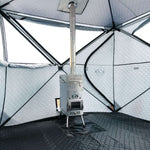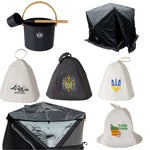When most people think of a sauna, they imagine the steam, the sweat, and the release. But beneath that ritual is one essential question: how hot does a sauna actually get, and how hot should it be?
Whether you’re new to heat therapy or chasing that perfect löyly moment, understanding sauna temperatures helps you choose the right setup, stay safe, and unlock the full benefits.
Here’s a streamlined breakdown by types of saunas, what each feels like, and why higher heat, done right, can be transformative.
Ideal Sauna Temperature by Type: A Side-by-Side Comparison

Choosing a sauna type isn’t just about installation, it’s about intention. Each setup comes with its own heating method, temperature capabilities, and wellness benefits. Here's how they compare:
Infrared Saunas
-
Heat Source: Infrared lamps
-
Temperature Range: 120°F–150°F
-
Humidity: None (dry)
-
Experience: Gentle, low-intensity warmth; heats the body directly
-
Ideal For: Users with low heat tolerance or looking for longer sessions at milder temperatures
-
Limitations: No steam, no rocks, no ritual. Doesn’t raise the ambient air temperature or core body temperature as efficiently.
Electric Saunas
-
Heat Source: Electric heating element
-
Temperature Range: 150°F–190°F
-
Humidity: Adjustable with water on rocks
-
Experience: Controlled, accessible dry heat
-
Ideal For: Home spas, gyms, or setups where firewood is impractical
-
Limitations: Limited airflow dynamics, lacks the sensory depth and natural atmosphere of wood-fired heat
Traditional Wood-Burning Saunas (Like Kyfe)
-
Heat Source: Real wood-burning stove
-
Temperature Range: 160°F–210°F+ (Kyfe consistently exceeds 200°F)
-
Humidity: Steam on-demand with real sauna stones
-
Experience: Traditional Finnish-style heat with full ritual, scent of fire, and dynamic temperature control
-
Ideal For: Users seeking high-performance heat, authentic sauna culture, and outdoor flexibility
-
Standout Feature: Kyfe’s portable wood-fired system is the only sauna in its class offering this level of temperature intensity and traditional steam
Traditional saunas have long been the cornerstone of authentic sauna bathing, offering intense, dry heat and the ritual of steam on rocks. Whether you choose an electric or wood burning setup, a traditional sauna allows you to fine-tune each session to your desired temperature, making it one of the most adaptable and rewarding traditional saunas available.
The verdict? Infrared saunas are mild and modern. Electric saunas are reliable but lack soul. Wood-burning models, especially Kyfe, offer the richest, most complete sauna experience.
What Makes a Finnish Sauna Unique?
A traditional finnish sauna is more than a room, it’s a ritual. With its roots in silence, simplicity, and breath, it’s about presence, not just sweat.
Unlike modern spas or steam rooms, Finnish saunas give you control over heat and humidity. You decide when to add löyly and when to step out. That intention is everything.
Kyfe is built to honor that lineage, bringing you the fire, the rocks, and the space to reset.
Infrared vs Electric vs Wood-Burning Saunas: Which Delivers the Best Experience?

-
Infrared: Gentle, tech-forward, no steam; best for therapy-focused users
-
Electric: Convenient, easy to control; lacks the raw intensity of fire
-
Wood-Burning (Kyfe): Primal, adjustable, and atmospheric; delivers the full sauna experience
Generally speaking, your choice comes down to what kind of heat, and ritual, you want to build into your life.
Ideal Temperature for Your Session
Your perfect sauna temperature can shift daily. Some days call for stillness at 150°F. Others, a sharp flush at 195°F. If you’re seeking deeper therapeutic benefits, steam at high heat works best. For gentler rhythms or beginners, lower temperatures help build tolerance. A lower steam sauna temperature can be just as effective at promoting relaxation, offering a gentler heat experience with deeply calming benefits.
Best Sauna Temperature: Why Higher Heat is Deeper

The Role of Real Sauna Rocks
Kyfe includes 35 lbs of rocks to hold and radiate heat. When water hits them, it raises the humidity level instantly, enhancing intensity and sweat depth.
Dry Heat vs Wet Heat: How the Body Responds
Dry saunas raise your core body temperature quickly, triggering circulation and endorphin release. Wet heat, like in steam rooms, feels heavier, with slower onset but deeper skin saturation.
Both support stress relief, muscle relaxation, and nervous system recovery. The right choice depends on your preference and sauna routine goals.
How to Find Your Best Temperature
Your perfect sauna temperature can change from day to day. Some sessions may call for high heat and intensity, while others feel better at a gentler pace. The goal is always to feel lighter, clearer, and more grounded afterward.
For deeper therapeutic benefits, 180°F to 195°F with steam is ideal. For shorter sessions or regular use, 150°F–170°F is often the right temperature to support consistency without overwhelm.
Your ideal range also depends on your sauna type. A steam sauna may run at a lower temperature range, around 110°F to 120°F, but the humidity makes it feel much hotter. In contrast, dry heat from a traditional setup like Kyfe feels more gradual and balanced.
As your body adjusts, you’ll sweat more easily, stay longer, and find your rhythm. Whether you prefer a traditional Finnish sauna, an infrared setup, or fire-fueled heat, the key is to listen to your body, and let that guide your practice.
Always follow safety precautions, stay hydrated, and rest between rounds.
Finnish Saunas and the Art of Daily Ritual
A traditional Finnish sauna is about more than heat, it’s about rhythm and reset. Most sessions follow a simple pattern: heat, cold, rest, repeat. Over time, this builds resilience and helps the body regulate itself.
Unlike fixed-humidity steam rooms, a traditional Finnish sauna gives you control. You decide how hot it gets and when to add steam, which sharpens focus and supports recovery.
For many sauna users, this becomes more than routine, it becomes a daily ritual that supports immunity, sleep, and helps improve cardiovascular health.
With Kyfe, this timeless tradition is portable, ready for your backyard, driveway, or anywhere you want to connect with heat and presence.
Cardiovascular Health and Sauna Use
Few tools are as effective at helping improve cardiovascular health as regular sauna use. As sauna temperature rises, heart rate increases, blood vessels dilate, and circulation improves. That gentle pressure on your vascular system mimics the effects of moderate cardio, without the movement.
This effect holds across many sauna types: from wood-burning to electric to infrared. While methods differ, the benefits remain consistent. With time and consistency, your blood pressure may decrease, inflammation may lower, and endurance may rise.
Your heat tolerance will also evolve. As your body adjusts, your ability to stay longer and recover faster improves. But as always, proceed with awareness. If you have pre-existing medical issues, consult a trusted healthcare provider before beginning regular sessions.
Health Benefits of High-Temperature Sauna Sessions

-
Boosted blood flow and vascular efficiency
-
Faster muscle and joint recovery
-
Endorphin release and stress relief
-
Improved sleep and hormone regulation
-
Skin purification and collagen support
-
Nervous system reset and mental relaxation
-
Enhanced immune response and cellular repair
Whether you're aiming for physical recovery or psychological decompression, regular sessions in a sauna type that fits your goals, dry, steam, or infrared rays, will bring measurable, lasting results. And for those who prefer staying in for extended periods, lower heat sessions can be just as beneficial, especially when they’re consistent.
How to Reach and Maintain High Sauna Temperatures
Building and Managing a Wood Fire (Kyfe-Specific)
In a hot sauna like Kyfe, build your fire slowly, allowing stones to heat fully. Adjust air vents to hit your optimal temperature, usually 195°F+.
As the Finnish Sauna Society teaches: fire is sacred. Steam is earned. Be present with the process, and respect the heat.
Tent Ventilation and Temperature Control
Open the base vent for airflow. Use the chimney and flaps to control steam and temperature. Kyfe lets you manage your entire climate manually, something no button can replace.
That’s the power of this type of sauna: self-regulated, performance-driven, personal.
Smoke, Steam and the Power of Löyly
Water on rocks isn’t just tradition, it’s transformation. In steam rooms, humidity is constant. In Kyfe, it’s intentional.
Want a more humid experience? Add löyly regularly to mimic a steam room while retaining the heat of a dry sauna. It’s what makes Kyfe both high-performance and adaptive.
Personal Preference Shapes Every Session
Generally speaking, there’s no formula. Some days demand hotter temperatures. Others ask for stillness and lower heat. The more you sauna, the more your body will tell you what it needs.
Sauna depends on the user, not the model. Kyfe gives you the control to listen and respond.
For new users or those with medical considerations, always check with a healthcare provider first.
The Bottom Line: Heat with Purpose, Sweat with Intention
From smoke saunas to infrared light to modern steam rooms, there are many ways to sauna, but few deliver the control, performance, and ritual of Kyfe.
A hot sauna session is more than sweat. It’s how you come back to yourself.
Kyfe Sauna was designed for people who want more than just heat. You want clarity. Intention. Stillness. You want the fire.
Pick your fire. Set your pace. Let your body lead.
















